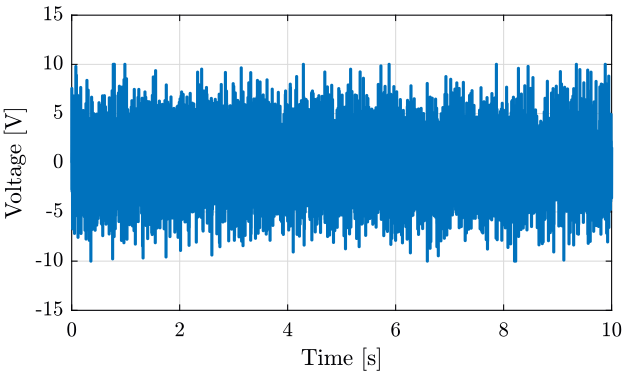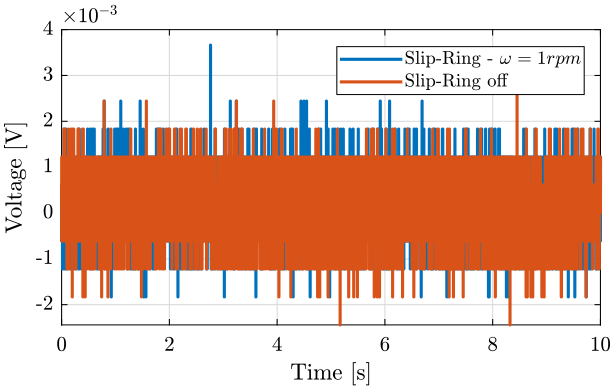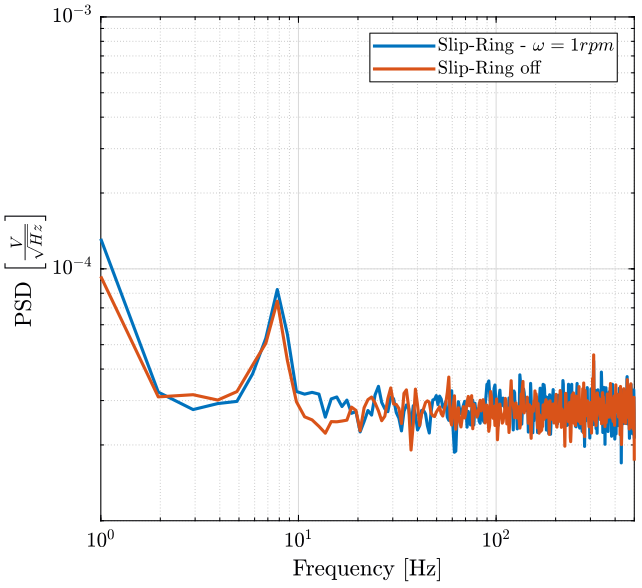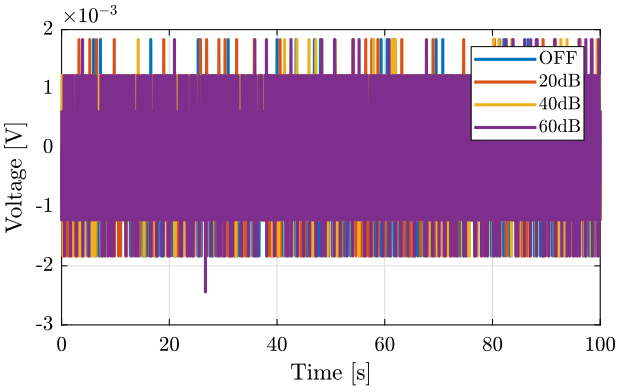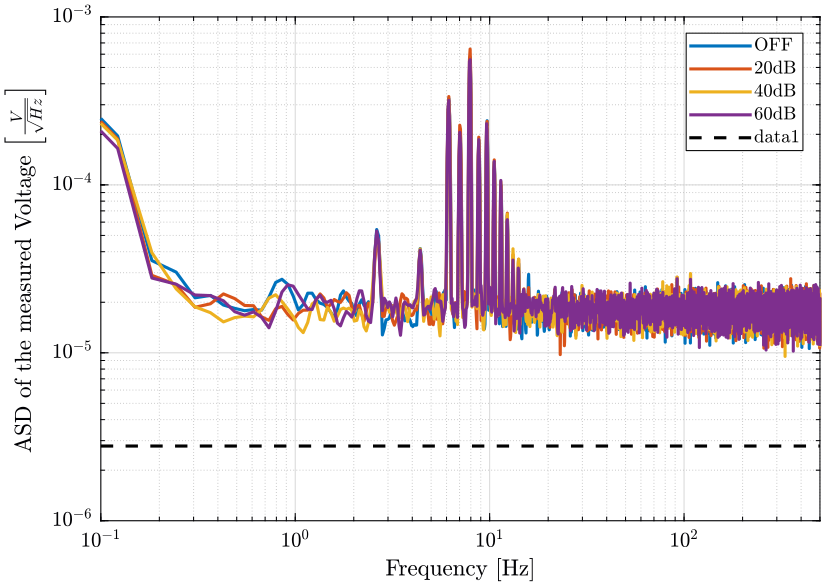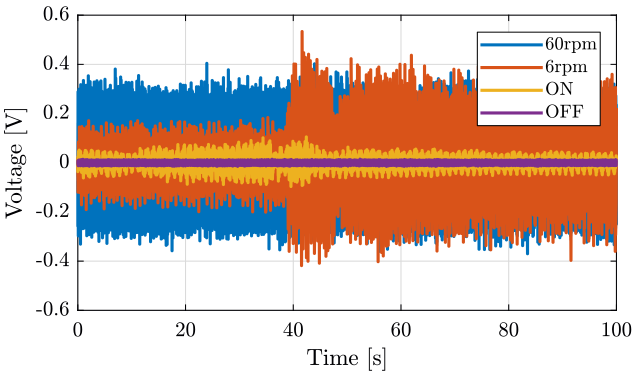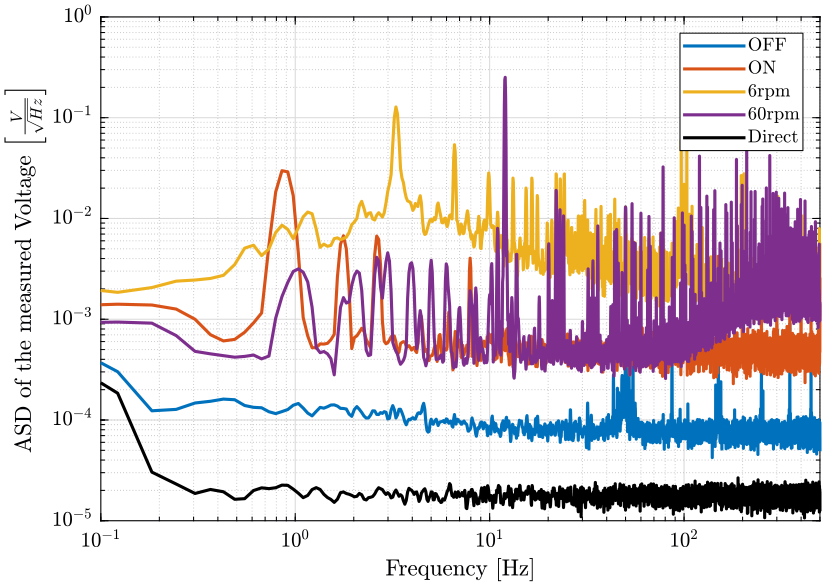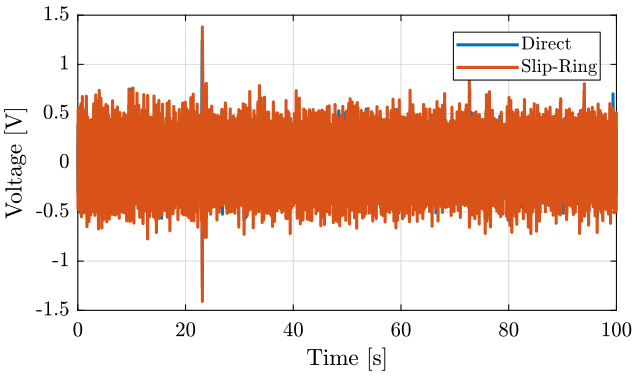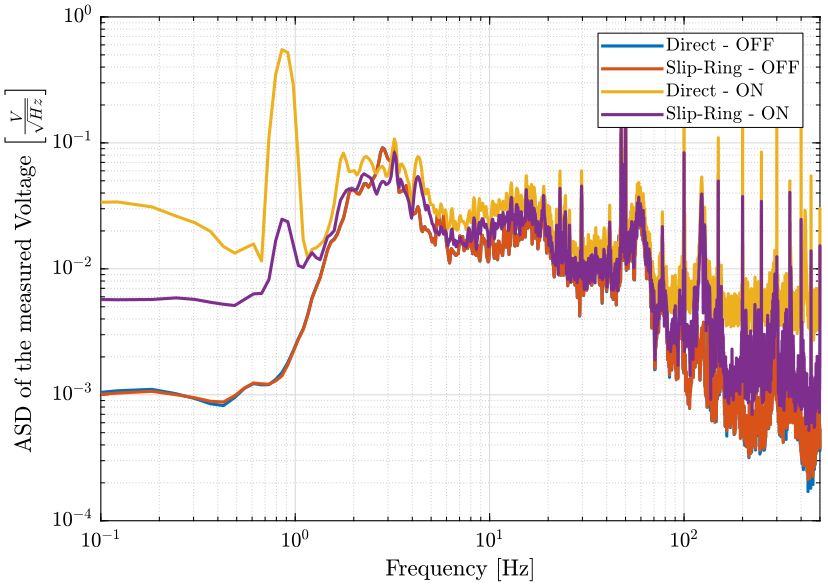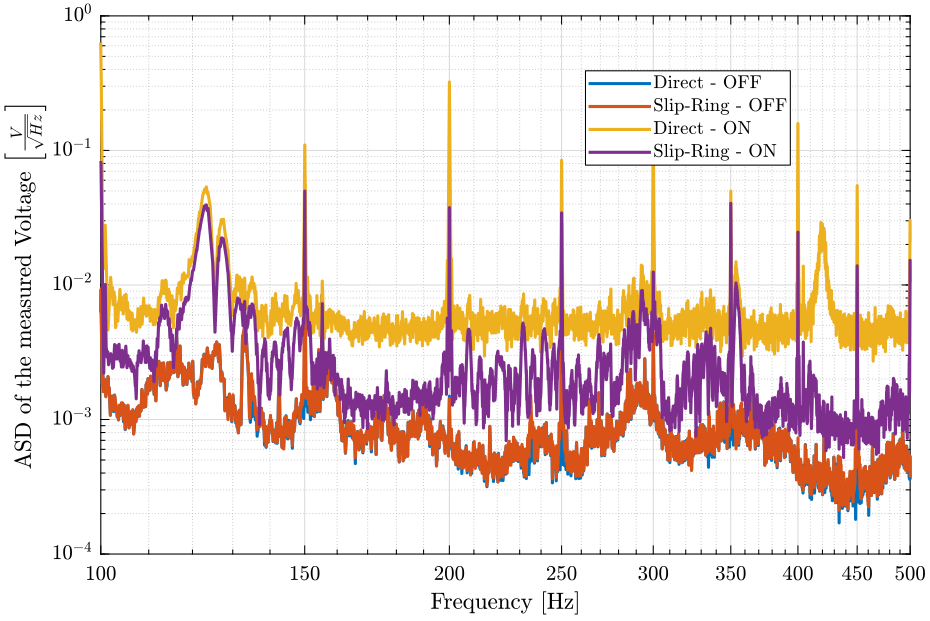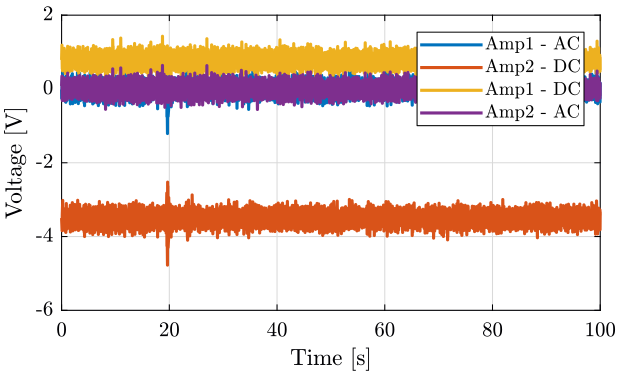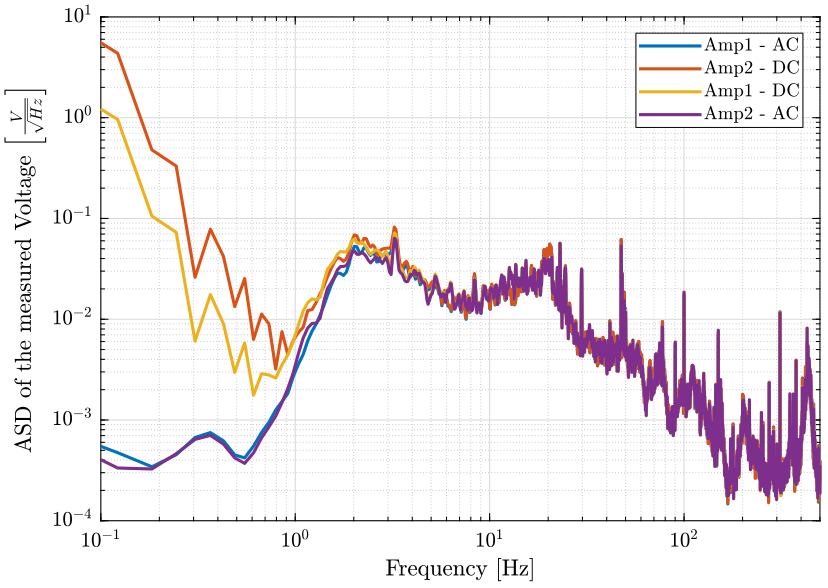24 KiB
Measurements
- Effect of the rotation of the Slip-Ring
- Measure of the noise of the Voltage Amplifier
- Measure of the noise induced by the Slip-Ring
- Measure of the noise induced by the slip ring when using a geophone
- Measure of the influence of the AC/DC option on the voltage amplifiers
Effect of the rotation of the Slip-Ring
The data and matlab files are accessible here.
Measurement Description
Random Signal is generated by one DAC of the SpeedGoat.
The signal going out of the DAC is split into two:
- one BNC cable is directly connected to one ADC of the SpeedGoat
- one BNC cable goes two times in the Slip-Ring (from bottom to top and then from top to bottom) and then is connected to one ADC of the SpeedGoat
Two measurements are done.
| Data File | Description |
|---|---|
mat/data_001.mat |
Slip-ring not turning |
mat/data_002.mat |
Slip-ring turning |
For each measurement, the measured signals are:
| Data File | Description |
|---|---|
t |
Time vector |
x1 |
Direct signal |
x2 |
Signal going through the Slip-Ring |
The goal is to determine is the signal is altered when the spindle is rotating.
Here, the rotation speed of the Slip-Ring is set to 1rpm.
Load data
We load the data of the z axis of two geophones.
sr_off = load('mat/data_001.mat', 't', 'x1', 'x2');
sr_on = load('mat/data_002.mat', 't', 'x1', 'x2');Analysis
Let's first look at the signal produced by the DAC (figure fig:random_signal).
figure;
hold on;
plot(sr_on.t, sr_on.x1);
hold off;
xlabel('Time [s]'); ylabel('Voltage [V]');
xlim([0 10]); <<plt-matlab>>We now look at the difference between the signal directly measured by the ADC and the signal that goes through the slip-ring (figure fig:slipring_comp_signals).
figure;
hold on;
plot(sr_on.t, sr_on.x1 - sr_on.x2, 'DisplayName', 'Slip-Ring - $\omega = 1rpm$');
plot(sr_off.t, sr_off.x1 - sr_off.x2,'DisplayName', 'Slip-Ring off');
hold off;
xlabel('Time [s]'); ylabel('Voltage [V]');
xlim([0 10]);
legend('Location', 'northeast'); <<plt-matlab>> dt = sr_on.t(2) - sr_on.t(1);
Fs = 1/dt; % [Hz]
win = hanning(ceil(1*Fs)); [pxx_on, f] = pwelch(sr_on.x1 - sr_on.x2, win, [], [], Fs);
[pxx_off, ~] = pwelch(sr_off.x1 - sr_off.x2, win, [], [], Fs); <<plt-matlab>>Conclusion
Remaining questions:
- Should the measurement be redone using voltage amplifiers?
- Use higher rotation speed and measure for longer periods (to have multiple revolutions) ?
Measure of the noise of the Voltage Amplifier
The data and matlab files are accessible here.
Measurement Description
Goal:
- Determine the Voltage Amplifier noise
Setup:
- The two inputs (differential) of the voltage amplifier are shunted with 50Ohms
- The AC/DC option of the Voltage amplifier is on AC
- The low pass filter is set to 1hHz
- We measure the output of the voltage amplifier with a 16bits ADC of the Speedgoat
Measurements:
data_003: Ampli OFFdata_004: Ampli ON set to 20dBdata_005: Ampli ON set to 40dBdata_006: Ampli ON set to 60dB
Load data
amp_off = load('mat/data_003.mat', 'data'); amp_off = amp_off.data(:, [1,3]);
amp_20d = load('mat/data_004.mat', 'data'); amp_20d = amp_20d.data(:, [1,3]);
amp_40d = load('mat/data_005.mat', 'data'); amp_40d = amp_40d.data(:, [1,3]);
amp_60d = load('mat/data_006.mat', 'data'); amp_60d = amp_60d.data(:, [1,3]);Time Domain
The time domain signals are shown on figure fig:ampli_noise_time.
<<plt-matlab>>Frequency Domain
We first compute some parameters that will be used for the PSD computation.
dt = amp_off(2, 2)-amp_off(1, 2);
Fs = 1/dt; % [Hz]
win = hanning(ceil(10*Fs));
Then we compute the Power Spectral Density using pwelch function.
[pxoff, f] = pwelch(amp_off(:,1), win, [], [], Fs);
[px20d, ~] = pwelch(amp_20d(:,1), win, [], [], Fs);
[px40d, ~] = pwelch(amp_40d(:,1), win, [], [], Fs);
[px60d, ~] = pwelch(amp_60d(:,1), win, [], [], Fs);We compute the theoretical ADC noise.
q = 20/2^16; % quantization
Sq = q^2/12/1000; % PSD of the ADC noiseFinally, the ASD is shown on figure fig:ampli_noise_psd.
<<plt-matlab>>Conclusion
Noise induced by the voltage amplifiers is not a limiting factor.
Measure of the noise induced by the Slip-Ring
The data and matlab files are accessible here.
Measurement Description
Goal:
- Determine the noise induced by the slip-ring
Setup:
- 0V is generated by the DAC of the Speedgoat
- Using a T, one part goes directly to the ADC
- The other part goes to the slip-ring 2 times and then to the ADC
- The parameters of the Voltage Amplifier are: 80dB, AC, 1kHz
- Every stage of the station is OFF
First column: Direct measure Second column: Slip-ring measure
Measurements:
data_008: Slip-Ring OFFdata_009: Slip-Ring ONdata_010: Slip-Ring ON and omega=6rpmdata_011: Slip-Ring ON and omega=60rpm
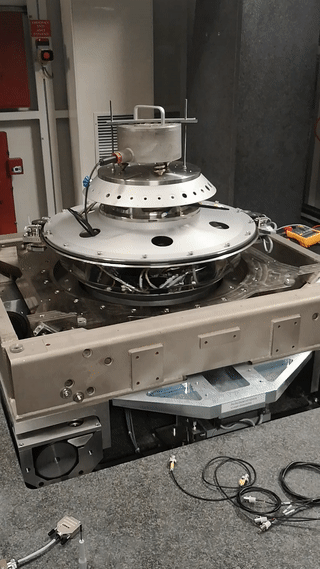
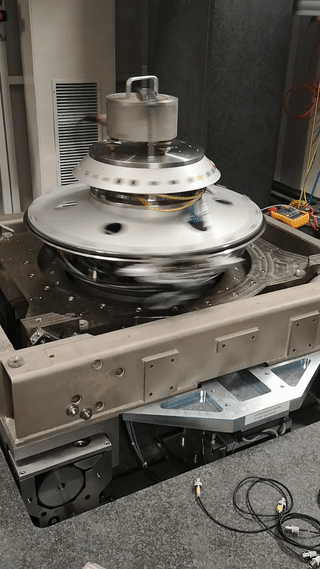
Load data
We load the data of the z axis of two geophones.
sr_off = load('mat/data_008.mat', 'data'); sr_off = sr_off.data;
sr_on = load('mat/data_009.mat', 'data'); sr_on = sr_on.data;
sr_6r = load('mat/data_010.mat', 'data'); sr_6r = sr_6r.data;
sr_60r = load('mat/data_011.mat', 'data'); sr_60r = sr_60r.data;Time Domain
We plot the time domain data for the direct measurement (figure fig:sr_direct_time) and for the signal going through the slip-ring (figure fig:sr_slipring_time);
<<plt-matlab>> <<plt-matlab>>Frequency Domain
We first compute some parameters that will be used for the PSD computation.
dt = sr_off(2, 3)-sr_off(1, 3);
Fs = 1/dt; % [Hz]
win = hanning(ceil(10*Fs));
Then we compute the Power Spectral Density using pwelch function.
[pxdir, f] = pwelch(sr_off(:, 1), win, [], [], Fs);
[pxoff, ~] = pwelch(sr_off(:, 2), win, [], [], Fs);
[pxon, ~] = pwelch(sr_on(:, 2), win, [], [], Fs);
[px6r, ~] = pwelch(sr_6r(:, 2), win, [], [], Fs);
[px60r, ~] = pwelch(sr_60r(:, 2), win, [], [], Fs);And we plot the ASD of the measured signals (figure fig:sr_psd_compare);
figure;
hold on;
plot(f, sqrt(pxoff), 'DisplayName', 'OFF');
plot(f, sqrt(pxon), 'DisplayName', 'ON');
plot(f, sqrt(px6r), 'DisplayName', '6rpm');
plot(f, sqrt(px60r), 'DisplayName', '60rpm');
plot(f, sqrt(pxdir), 'k-', 'DisplayName', 'Direct');
hold off;
set(gca, 'xscale', 'log');
set(gca, 'yscale', 'log');
xlabel('Frequency [Hz]'); ylabel('ASD of the measured Voltage $\left[\frac{V}{\sqrt{Hz}}\right]$')
legend('Location', 'northeast');
xlim([0.1, 500]); <<plt-matlab>>Conclusion
Measure of the noise induced by the slip ring when using a geophone
The data and matlab files are accessible here.
Measurement Description
Goal:
- Determine if the noise induced by the slip-ring is a limiting factor when measuring the signal coming from a geophone
Setup:
- The geophone is located at the sample location
-
The two Voltage amplifiers have the following settings:
- AC
- 60dB
- 1kHz
-
The signal from the geophone is split into two using a T-BNC:
- One part goes directly to the voltage amplifier and then to the ADC.
- The other part goes to the slip-ring=>voltage amplifier=>ADC.
First column: Direct measure Second column: Slip-ring measure
Measurements:
data_012: Slip-Ring OFFdata_013: Slip-Ring ON
Load data
We load the data of the z axis of two geophones.
sr_off = load('mat/data_012.mat', 'data'); sr_off = sr_off.data;
sr_on = load('mat/data_013.mat', 'data'); sr_on = sr_on.data;Time Domain
We compare the signal when the Slip-Ring is OFF (figure fig:sr_geophone_time_off) and when it is ON (figure fig:sr_geophone_time_on).
<<plt-matlab>> <<plt-matlab>>Frequency Domain
We first compute some parameters that will be used for the PSD computation.
dt = sr_off(2, 3)-sr_off(1, 3);
Fs = 1/dt; % [Hz]
win = hanning(ceil(10*Fs));
Then we compute the Power Spectral Density using pwelch function.
% Direct measure
[pxdoff, ~] = pwelch(sr_off(:, 1), win, [], [], Fs);
[pxdon, ~] = pwelch(sr_on(:, 1), win, [], [], Fs);
% Slip-Ring measure
[pxsroff, f] = pwelch(sr_off(:, 2), win, [], [], Fs);
[pxsron, ~] = pwelch(sr_on(:, 2), win, [], [], Fs);Finally, we compare the Amplitude Spectral Density of the signals (figure );
figure;
hold on;
plot(f, sqrt(pxdoff), 'DisplayName', 'Direct - OFF');
plot(f, sqrt(pxsroff), 'DisplayName', 'Slip-Ring - OFF');
plot(f, sqrt(pxdon), 'DisplayName', 'Direct - ON');
plot(f, sqrt(pxsron), 'DisplayName', 'Slip-Ring - ON');
hold off;
set(gca, 'xscale', 'log');
set(gca, 'yscale', 'log');
xlabel('Frequency [Hz]'); ylabel('ASD of the measured Voltage $\left[\frac{V}{\sqrt{Hz}}\right]$')
legend('Location', 'northeast');
xlim([0.1, 500]); <<plt-matlab>> <<plt-matlab>>Conclusion
- When the slip-ring is OFF, it does not add any noise to the measurement
- When the slip-ring is ON, it adds significant noise to the signal
Measure of the influence of the AC/DC option on the voltage amplifiers
The data and matlab files are accessible here.
Measurement Description
Goal:
- Measure the influence of the high-pass filter option of the voltage amplifiers
Setup:
- One geophone is located on the marble.
- It's signal goes to two voltage amplifiers with a gain of 60dB.
- One voltage amplifier is on the AC option, the other is on the DC option.
Measurements:
First measurement (mat/data_014.mat file):
| Column | Signal |
|---|---|
| 1 | Amplifier 1 with AC option |
| 2 | Amplifier 2 with DC option |
| 3 | Time |
Second measurement (mat/data_015.mat file):
| Column | Signal |
|---|---|
| 1 | Amplifier 1 with DC option |
| 2 | Amplifier 2 with AC option |
| 3 | Time |
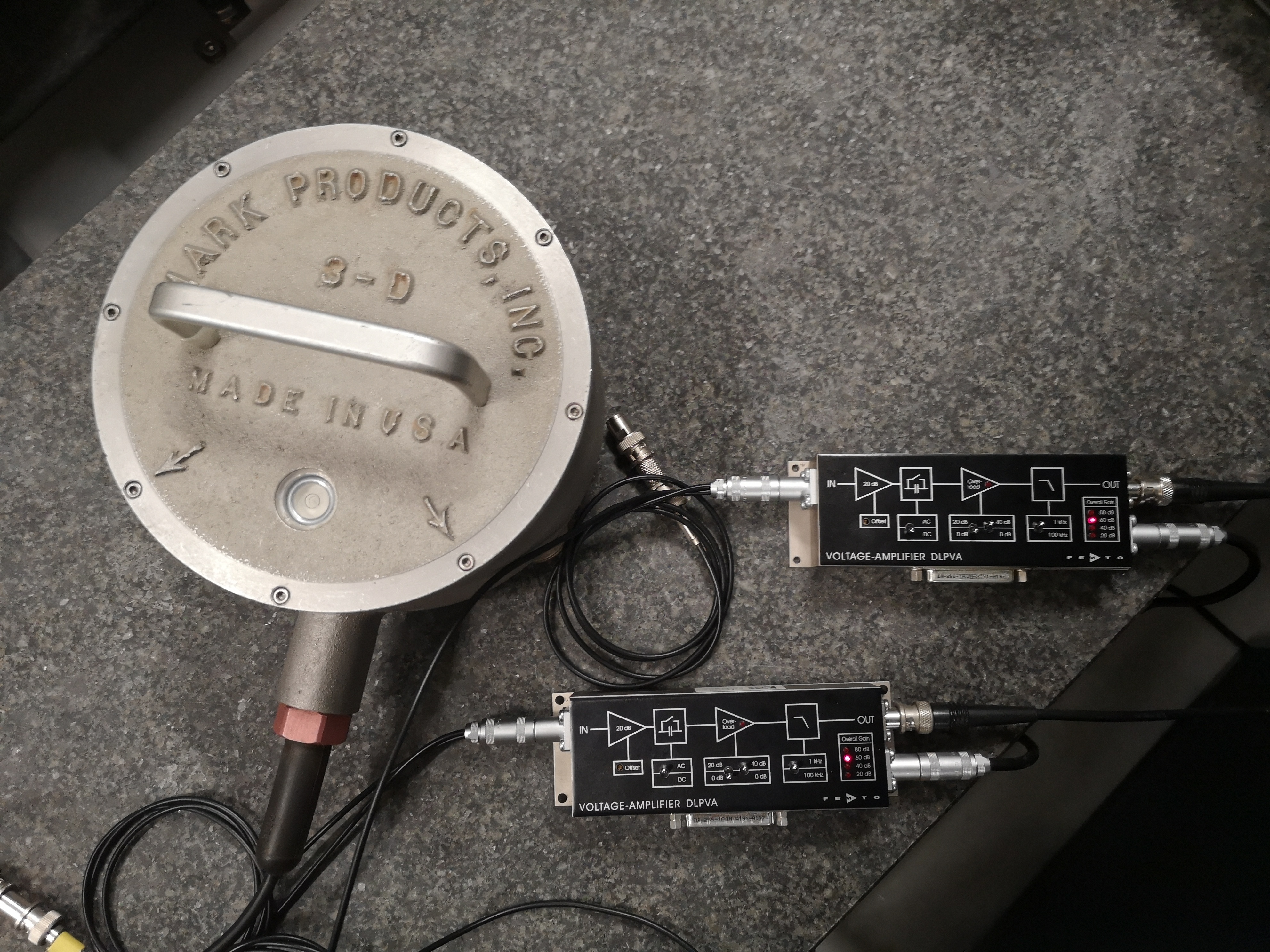
Load data
We load the data of the z axis of two geophones.
meas14 = load('mat/data_014.mat', 'data'); meas14 = meas14.data;
meas15 = load('mat/data_015.mat', 'data'); meas15 = meas15.data;Time Domain
The signals are shown on figure fig:ac_dc_option_time.
<<plt-matlab>>Frequency Domain
We first compute some parameters that will be used for the PSD computation.
dt = meas14(2, 3)-meas14(1, 3);
Fs = 1/dt; % [Hz]
win = hanning(ceil(10*Fs));
Then we compute the Power Spectral Density using pwelch function.
[pxamp1ac, f] = pwelch(meas14(:, 1), win, [], [], Fs);
[pxamp2dc, ~] = pwelch(meas14(:, 2), win, [], [], Fs);
[pxamp1dc, ~] = pwelch(meas15(:, 1), win, [], [], Fs);
[pxamp2ac, ~] = pwelch(meas15(:, 2), win, [], [], Fs);The ASD of the signals are compare on figure fig:ac_dc_option_asd.
<<plt-matlab>>